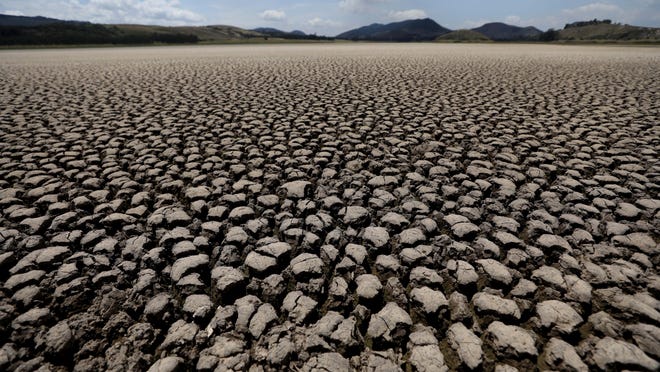A dangerous and sweltering heat wave will continue to consume much of the western U.S., especially California on Friday through the Labor Day weekend, the National Weather Service said.
The intense heat is putting a strain on the electrical grid and exacerbating wildfire concerns, which only grew Friday as a fast-moving fire forced at least 5,000 residents to evacuate in Northern California.
Temperatures in the mid- to upper 90s and lower 100s will result in widespread daily records each day for much of the region, the Weather Service said.
The National Weather Service said notorious hot spot Death Valley soared to 124 degrees Friday, nearing the hottest September temperature ever recorded on Earth of 126 degrees. The hellish location already holds the record for the world’s hottest temperature of 134 degrees, set in 1913.
About 50 million people, mostly in the Western U.S., were under excessive heat warnings and watches along with heat advisories on Friday. Nearly all of California is under an excessive heat waring.
Other temperature records likely to be broken
Elsewhere, many monthly temperature records are likely to be broken in inland areas of California, according to UCLA climate scientist Daniel Swain.
Death Valley inched toward breaking the highest September temperature ever recorded on Earth, reaching a sweltering 124 degrees on Friday. The record is 126 degrees.
Forecasters cautioned that Death Valley’s famous Furnace Creek thermometer could produce even higher readings.
“That’s not the official thermometer – so that would actually not be used to set the records,” said Brian Planz, a meteorologist with the National Weather Service in Las Vegas.
“Little to no relief from the heat overnight will only increase the heat stress and create a potentially dangerous situation for sensitive individuals,” the Weather Service warned.
HIGH HEAT:What is the hottest temperature ever recorded? Where on Earth was it?
“This heat may produce a very high risk of heat illness,” the Weather Service in Los Angeles said.
The Capital Weather Gang said, “Close to 38 million people, the vast majority of them in California and Arizona, are predicted to experience highs hitting the century mark in the coming week.”
IS FALL REALLY HERE?:Today is the first day of fall, meteorologists say. But it won’t feel like it in the West.
AccuWeather chief meteorologist Jonathan Porter said: “The risks associated with this heat wave are even more concerning than other heat waves because this will be happening through the Labor Day weekend, a holiday weekend when many people are spending additional time outdoors and may be less aware of the heat risks.
“The heat wave will be notable due to its persistence – day after day of extreme heat with temperatures, in some locations such as California’s capital of Sacramento, near or exceeding 110 degrees for three or more days in a row,” Porter said.
“Extreme caution” is advised for people who go outdoors, the Weather Service in Sacramento said.
Wildfire, power concerns
Wildfires and power outages were high on the list of concerns among California officials on Friday.
In California, wildfires chewed through rural areas north of Los Angeles and east of San Diego, racing through bone-dry brush and prompting evacuations.
POWER PROBLEMS?:California hopes to avoid blackouts amid heat wave by asking millions of people to use less electricity
In northwestern Los Angeles County, the intense Route Fire near Castaic raged through more than 8 square miles of hills containing scattered houses late Wednesday. Traffic was snarled on Interstate 5, a major north-south route running through the fire area. Containment was estimated at 37% Friday morning.
Wednesday, seven firefighters fighting the blaze in triple-digit temperatures were taken to hospitals for heat-related illness. All were released.
More than 1,500 people had to evacuate eastern San Diego County when the Border 32 fire erupted Wednesday, eventually hospitalizing two and destroying 10 structures. As of Friday, the fire remained at just under 7 square miles and containment increased to 20%.
And in Northern California, a fast-moving fire forced at least 5,000 residents to evacuate and threatened hundreds of homes after the blaze spread to 500 acres in about an hour, the Siskiyou Sheriff’s Office said in a statement.
State officials hope to avoid rolling blackouts by asking residents to voluntarily use less power, even as the heat tempts Californians to crank up their air conditioners.
“One of the big unknowns in this (whether blackouts will happen) is that we also expect wildfires,” said Daniel Kammen, an energy professor at the University of California, Berkeley: “And wildfires will cause us to have to shut down certain transmission lines, de-energizing them to prevent wildfires.
“Then we could get into a situation where those rolling brownouts, we call them, when they’re scheduled, we tell people in advance. But right now, none of them are anticipated,” Kammen told USA TODAY.
CLIMATE CONNECTION:Extreme heat waves may be our new normal, thanks to climate change. Is the globe prepared?
Contributing: Celina Tebor, USA TODAY; The Associated Press


